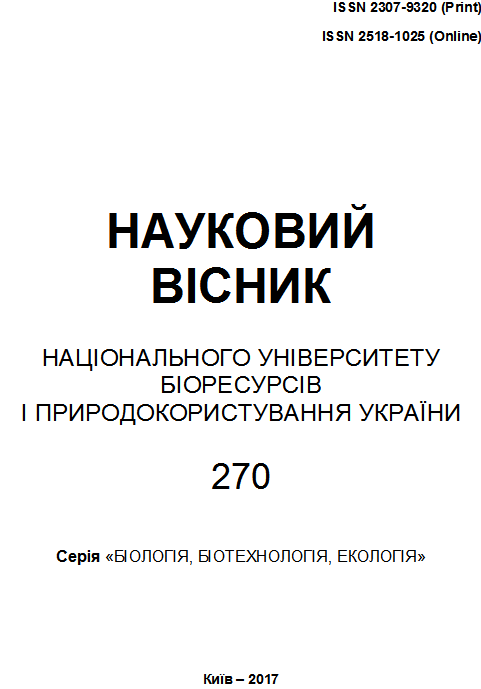FORMATION OF SURFACELY PROGRAMMED, CHEMICAL CREATED SITES AND WAYS OF ESTIMATION OF THEIR SELECTIVITY TO DIFFERENT MYCOTOXINES
Анотація
The problem of mycotoxins as potential food contaminants has become widespread in violation of the requirements of intensive processing technologies for agricultural crops and the loss of plant resistance to phytopathogens. Growth in the content of mycotoxins in food is also directly related to the uncontrolled use of nitrogen fertilizers and pesticides. The article presents experimental studies on the search for the most effective ways of forming selective chemical sites aimed at quantifying individual mycotoxins using sensory technology. It has been established that the registration of the formation of the corresponding specific complex can be carried out potentiometrically and optically on the basis of the PPR principle. It was revealed that when registering the specific complex created for and using the PPR principle, the transducer surface must be pretreated with PAA. A tried-and-true method of forming selective matrix-programmed surfaces can be recommended for the sake of terrestrial transducer surface sensors aimed at screening mycotoxins among environmental objects. It is determined that the surface structures programmed can be restored for reuse by washing them with acetonitrile or methanol. When reused more than 10 times the specific signal changes only within 10%.
Посилання
Starodub N. F., Pilipenko L. N., Egorova A. V., Pylypenko I. V., Goyster O. S., Khmelnitsky G. O. (2008). Analiz micotoxinov: podgotovka prob [Mycotoxin analysis: preparation of samples]. Biotechnology. Vol. 1, No. 1. - P. 106-115.
Starodub N.F., Pylypenko I.V., Pylypenko L.N., Mel’nichenko M. M., Nabok A.V. (2010). Biosensors for the Determination of Mycoyoxins: development, efficiency at the analysis of model samples and in case of the practical applications. Lecture Notes of the ICB, 86. Р. 81-101.
Nabok A.V., Tsargorodskaya A., Holloway A., Starodub N.F., Gojster O. (2007). Registration of T-2 mycotoxin with total internal reflection ellipsometry and QCM impedance methods. Biosensors and Bioelectronics, №22. Р. 885-890.
Starodub N. F., Taran M. V., Shpirka N. F., Shavanova K. E. (2016). Fiber optic SOS-type biosensor for the control of the genotoxicity of some environmental objects. World journal of engineering research and technlogy, Vol. 2. P. 123-130.
Smirnov V., Zajchenko F., Rubegnjak I. (2000). Mycotoxins: fundamental and applied aspects. Modern problems of toxicology, №1. Р. 5-12.
Завантаження
Опубліковано
Номер
Розділ
Ліцензія
Стосунки між правовласниками і користувачами регулюються на умовах ліцензії Creative Commons Із Зазначенням Авторства – Некомерційна – Поширення На Тих Самих Умовах 4.0 Міжнародна (CC BY-NC-SA 4.0):https://creativecommons.org/licenses/by-nc-sa/4.0/deed.uk
Автори, які публікуються у цьому журналі, погоджуються з наступними умовами:
- Автори залишають за собою право на авторство своєї роботи та передають журналу право першої публікації цієї роботи на умовах ліцензії Creative Commons Attribution License, котра дозволяє іншим особам вільно розповсюджувати опубліковану роботу з обов'язковим посиланням на авторів оригінальної роботи та першу публікацію роботи у цьому журналі.
- Автори мають право укладати самостійні додаткові угоди щодо неексклюзивного розповсюдження роботи у тому вигляді, в якому вона була опублікована цим журналом (наприклад, розміщувати роботу в електронному сховищі установи або публікувати у складі монографії), за умови збереження посилання на першу публікацію роботи у цьому журналі.
- Політика журналу дозволяє і заохочує розміщення авторами в мережі Інтернет (наприклад, у сховищах установ або на особистих веб-сайтах) рукопису роботи, як до подання цього рукопису до редакції, так і під час його редакційного опрацювання, оскільки це сприяє виникненню продуктивної наукової дискусії та позитивно позначається на оперативності та динаміці цитування опублікованої роботи (див.The Effect of Open Access).

